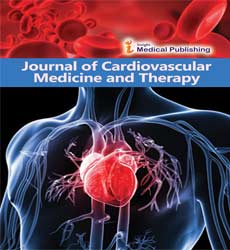HIV and Cardiovascular Medicine Therapy
Zeny Joy*
Department of Medicine, University of Pamplona, Colombia
- *Corresponding Author:
- Zeny Joy
Department of Medicine, University of Pamplona,
Colombia,
Tel: 9063251480;
E-mail: zenyjoy198@gmail.com
Received: 18-Feb-2022, Manuscript No. IPCMT-22-11506; Editor assigned: 21-Feb-2022, PreQC No. IPCMT-22-11506 (PQ); Reviewed: 7- Mar-2022, QC No. IPCMT-22-11506; Revised: 11-Mar-2022, Manuscript No. IPCMT-22-11506 (R); Published: 18-Mar-2022, DOI: 10.36648/ipcmt.22.5.1.002
Citation: Joy Z (2022) HIV and Cardiovascular Medicine Therapy. J Cardiovasc Med Ther Vol:5 No: 1
Editorial
As the Human Immunodeficiency Virus (HIV) pandemic enters its third decade, Acquired Immunodeficiency Syndrome (AIDS) has evolved into a global health issue, affecting around 36 million people worldwide. 1 and 2 In many parts of the United States and Europe, the disease is now the leading cause of death among young adults, while morbidity and mortality have increased six fold in Sub-Saharan Africa, where many people lack access to modern health care. Furthermore, over one million children live with HIV/AIDS worldwide and 1600 babies are born with the virus every day.
Early therapeutic aims were on extending life by aggressively treating opportunistic diseases like Pneumocystis carinii pneumonia, which are often fatal. During the 1980s, specific HIV-related myocarditis and cardiomyopathy were described and overall mortality decreased as opportunistic infection prophylaxis and clinical surveillance programmes improved. The introduction of combination Highly Active Antiretroviral Therapy (HAART) in the mid-1990s had a significant influence on HIV patient morbidity and death. Combination therapy decreases viral replication, slows disease progression, and extends survival time while also decreasing viral resistance development. Coronary artery disease, either de novo or as an iatrogenic consequence of modern treatment regimens, is developing as a major concern.
We recommend overhauling our current system to enable timely and accurate access to outcome data in the local practice context, so that practice improvement occurs voluntarily rather with high-risk patients, possibly through compensation in regression models used to assess expected outcomes, as well as for the on boarding of rookie clinicians, must be devised. To encourage clinical research, special provisions are required. It would be ideal to provide a complete disclosure informed consent before procedures are performed, in which the physician reveals operator-specific data and the patient's decision-making process is aided. Overall, the implementation of scorecards could lead to a significant improvement in the quality of cardiovascular medicine in the United States. Novel technologies that harness the heart's regenerative capacity are desperately needed, given the increased prevalence of cardiovascular illness worldwide and the limited therapy choices for severe heart failure. In contrast to most existing medical therapies, which primarily treat the symptoms of heart failure, stem cell therapy has the potential to repair myocardial injury and enhance cardiac function. Most cell types are safe, according to nearly two decades of research and over 200 trials for cardiovascular disease; nevertheless, their efficacy is still debatable, impeding the translation of this therapy from research to practice. Higher fidelity of cell isolation techniques, standardization of circumstances, more consistent use of stateof- the-art measurement tools, and assessment of various end points to gather insights into the efficacy of stem cells are all driving the design of new clinical trials. Individual patient variables are anticipated to play a substantial impact in stem cell efficacy, and translation to clinical trials has nearly exceeded our mechanistic understanding.
Open Access Journals
- Aquaculture & Veterinary Science
- Chemistry & Chemical Sciences
- Clinical Sciences
- Engineering
- General Science
- Genetics & Molecular Biology
- Health Care & Nursing
- Immunology & Microbiology
- Materials Science
- Mathematics & Physics
- Medical Sciences
- Neurology & Psychiatry
- Oncology & Cancer Science
- Pharmaceutical Sciences
